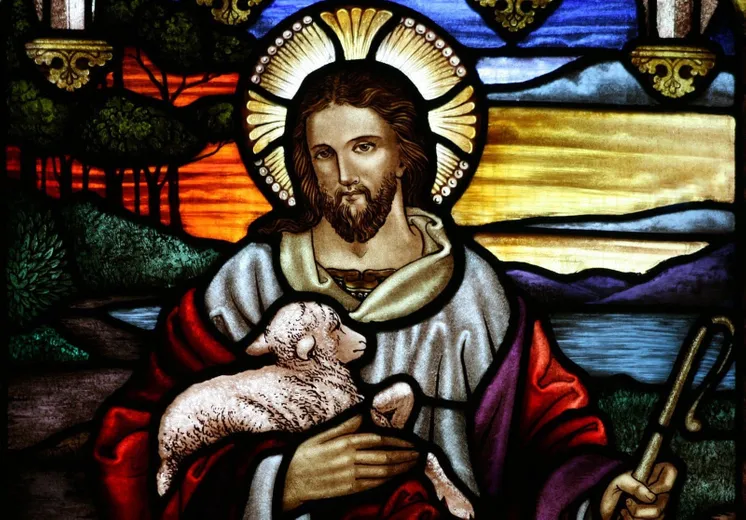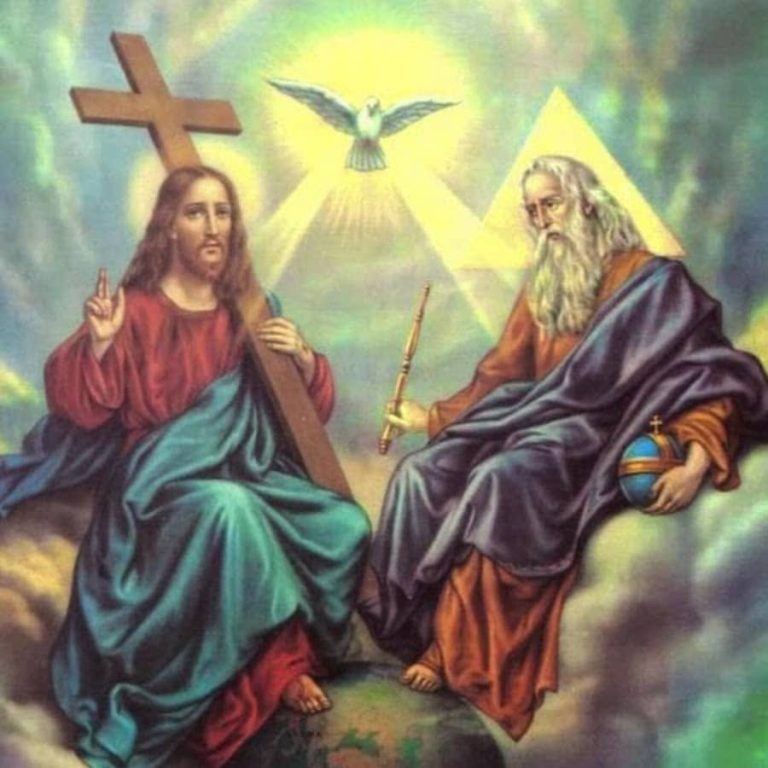Jesus, True God and True Man (Bible)
Jesus True God and True Man is the central enigma of Christian doctrine and is also the essential truth of Christological catechesis. Through the Incarnation, Jesus Christ admitted human nature, and stripped himself of his divinity and since then both coexisted in him, still being a subject of controversy in our days. We invite you to continue reading to learn even more.
Jesus Christ, True God and True Man
The proof that Jesus Christ is authentic man and authentic God, that is, the principle of the two natures or essences (hypostatic union), was established in the Council of Chalcedon (451 AD). This belief in the double essence of Jesus extends the horizon of human experience and imagination, coming to be considered a true enigma.
The materialization of the Son of God is outlined in Philippians 2:6-8 as a degradation of himself: “Who, having the form of God, did not consider equality with God a matter to be pursued, but renounced himself. himself, acquiring the form of a servant, formed similarly to men; and finding himself in the position of a man, he submitted to himself, becoming submissive even to death, and death on a cross ».
Jesus came to share with men the full range of physical and psychic perceptions. Just like a human being, he had a body and its corresponding needs. Luke 2:52 points out that Jesus grew in learning, importance and favor with God and men.
He rejoiced with the blessed at the wedding in Cana. He suffered with the sad and wept when Lazarus died. He felt hungry when he found himself in the desert; he made him thirsty when he came to Jacob’s fountain. He endured the pain of being whipped by the soldiers. Facing death on the cross, he said, “My soul is greatly afflicted, even to death” (Mt. 26:38).
Jesus Christ is truly authentic man; Hebrews 4:15 points this out. Here simultaneously the dissimilarity with all other men is highlighted: He has no fault, therefore, Jesus Christ is authentic God.
Holy Scripture provides evidence that Jesus Christ is the Son of God and equally that he is God. At the Baptism of Jesus a voice from heaven was heard: “This is my beloved Son, in whom I find satisfaction” (Mt. 3:17). Likewise in the transfiguration, the Father emphasized that Jesus is the Son of God, pointing out that we must listen to Him (Mt. 17:5).
What Jesus said: “No one can come to me unless the Father who sent me draws him” (Jn. 6:44) and “No one comes to the Father except through me” (Jn. 14:6) expresses that God the Father and God the Son have the same divine hierarchy. The Father has to lead man to the Son, and the Son leads man to the Father.
Only as true God Jesus Christ could assure: “I and the Father are the same” (Jn. 10:30), manifesting in simple language that he is of the same substance as the Father. Other biblical fragments that leave evidence that Jesus Christ is true God are detailed below:
- the way of acting of the Apostles after the ascension: “They, after having adored him [Jesus Christ], returned” (Lk. 24:52);
- what is said in John 1:18: “No man has ever seen God; the only Son, who is in the bosom of the Father, he has made him known”;
- what was pointed out by the Apostle Thomas after having contemplated the Risen One: “My Lord, and my God!” (John 20:28);
- the revelation of the essence of Christ in the hymn to Christ: “In him resides all the integrity of the Godhead bodily” (Col. 2:9);
- as testified in 1 John 5:20: “And we are found in the true one, in his Son Jesus Christ. This is the true God, and perpetual life”;
- the sentence: “God was expressed in the flesh” (1 Tim. 3:16).
Jesus Christ, God and true Man
Jesus Christ claimed the nature or essence of man without abandoning that of being God: he is authentic God and authentic man. Jesus Christ, the materialized Word, is neither a fable nor any imprecise conception; he is a man who existed in a specific context and who perished after leading his own existence within historical evolution. The inquiry about Him is, therefore, a demand of the Christian ideology.
The Incarnation of the Word
“At the fullness of time, God sent his Son, who came into the world as a woman” (Gal 4:4). Thus the promise of a Redeemer that God made to Adam and Eve when they were banished from Paradise has been achieved: «I will place rivalry between you and the woman, and between your offspring and her offspring; he will tread on your head while you lie in wait for his heel »(Gn 3, 15).
This fragment of Genesis is known as the protoevangelium, since it forms the initial announcement of the good news of redemption. It has usually been understood that the woman referred to is both Eve, in a direct way, and Mary, in the full sense; and that with the offspring of the woman both humanity and Christ are alluded to .
From then until the moment in which “the Word became flesh and resided among us” (Jn 1, 14), God was preparing humanity so that it could profitably welcome his only Son. God chose the people of Israel for himself, agreed with them on an Alliance and gradually formed it, interceding in its history, expressing its purposes through the patriarchs and prophets and glorifying it for itself.
And all of this, as an arrangement and figure of that new and finished Alliance that was to end in Christ and of that complete and determining revelation that had to be carried out by the materialized Word itself. Although God prepared the arrival of the Redeemer particularly through the choice of the people of Israel, this does not mean that he forsaken the other peoples, “the Gentiles”, since he never ceased to leave evidence of himself (cf. Acts 14, 16-17).
The Providence of God made the Gentiles achieve a relatively clear awareness of the need for redemption, and even in the farthest corners of the earth the desire to be saved was maintained.
The Incarnation originates in God’s love for humanity: “in it was expressed the love that God has for us, in that God sent his only Son into the world so that we might exist through him” (1 Jn 4:9). The Incarnation is the most notorious evidence of the Love of God towards humanity, since in it it is the Lord Himself who gives Himself to men, becoming part of the human essence in the unity of person.
After the misfortune or fall of Adam and Eve in Eden, the Incarnation has a saving and redemptive purpose, as is professed in the Creed: «for us humanity and for our redemption, he descended from heaven and materialized by the work of the Holy Spirit. Saint of the Virgin Mary, and became a man».
Christ assured of Himself that “the Son of man has come to seek and redeem what was lost” (Lk 19, 19; cf. Mt 18, 11) and that “God has not sent his Son to punish the world but so that the world may be redeemed through him” (Jn 3:17).
The Incarnation not only expresses the inexhaustible love of God for men, his endless compassion, justice and authority, but also the consistency of the divine plan of redemption. The deep divine erudition is expressed in how God has decided to redeem man, that is, in the most appropriate way to his nature, which is precisely through the Incarnation of the Word.
The fact that Christ existed is part of the doctrine of faith, as well as that he truly perished for us and that he was reborn on the third day (cf. 1 Cor 15, 3-11). The fact that Jesus existed is a fact verified by historical studies, particularly through the analysis of the New Testament whose historical importance is unquestionable. There are other non-Christian, pagan and Jewish ancestral testimonies about the existence of Jesus.
Precisely for this reason, the positions of those who confront a historical Jesus with the Christ of faith and are defenders of the thesis that almost everything that the New Testament expresses about Christ is what the proselytes of Jesus have interpreted as faith, are not admissible. but not his genuine historical figure who is still kept hidden from us.
These positions, which on numerous occasions entail a firm prejudice against the superhuman, have not realized that contemporary historical research agrees in assuring that the sample made by the original Christianity of Jesus is based on genuine events that really happened.
Jesus True God and True Man
The Incarnation is “the enigma of the admirable alliance of the divine essence and the human essence in the one Person of the Word” (Catechism, 483). The Incarnation of the Son of God “does not mean that Jesus Christ is partially God and partially man, nor that he is the fruit of a diffuse combination of the divine and the human.
He truly became man without truly ceasing to be God. Jesus Christ is authentic God and authentic man” (Catechism, 464). What is divine in Jesus Christ, perpetual Word of God, has been examined when considering the Holy Trinity. Here we will focus particularly on what is pertaining to his humanity.
The Church protected and clarified this truth of faith for the first centuries in the face of heresies that distorted it. As early as the first century, certain Christians of Jewish descent, the Ebionites, regarded Christ as a simple man, albeit quite holy. In the second century, adoptionism emerges, which held that Jesus was God’s adopted son; Jesus would only be a man in whom the vitality of God resides; for them, God was a single person.
This heresy was condemned in the year 190 by Pope Saint Victor, by the Council of Antioch in the year 268, by the Council of Constantinople and by the Roman Synod in the year 382. The Arian heresy, by refuting the divinity of the Word, refuted that it also Jesus Christ was God. Arius received the condemnation of the Council of Nicaea, in the year 325.
Also today the Church has again recalled that Jesus Christ is the Son of God enduring from eternity who in the Incarnation accepted the human essence in his own divine person. The Church also faced other errors that denied the truth of the human essence of Christ. Among them are framed those heresies that repudiated the truth of the body or soul of Christ.
Among the first we find Docetism, in its different variants, which has a Gnostic and Manichaean context. Some of his disciples claimed that Christ had a heavenly body, or that his body was totally feigned, or that he showed up spontaneously in Judea without having had a birth or development.
St. John had already had to fight against this kind of error: “many are the seducers who have made a presence in the world, who do not reveal that Jesus has come in the flesh” (2 Jn 7; cf. 1 Jn 4, 1-2)
Arius and Apollinaris of Laodicea refuted that Christ had a truly human soul. The second has obtained singular relevance in this field and its influence was present for several centuries in subsequent Christological disputes. In an attempt to protect the unity of Christ and his blamelessness, Apollinaris espoused the idea that the Word exercised the functions of the human spiritual soul.
This discipline, however, presupposed denying the authentic humanity of Christ, which consisted, as in every man, of body and spiritual soul (cf. Catechism, 471). He received condemnation at the First Council of Constantinople and at the Roman Synod of 382.
The Hypostatic Union
At the beginning of the fifth century, after the controversies that preceded it, the need to firmly support the integrity of the two human and divine essences in the Person of the Word became evident; in such a way that the particular unity of Christ begins to conform to the focus of Christology and patristic soteriology. For this novel deepening recent discussions served as collaboration.
The great initial controversy originated from some assertions of Nestorius, Patriarch of Constantinople, who used a language in which he made it understood that in Christ there are two subjects: the divine and the human, intertwined with each other by a moral bond, but not a physical one. His repudiation of the title of Mother of God, Theotókos, with which Holy Mary is designated, originates from this Christological misunderstanding. Mary would become the Mother of Christ but not of God.
In the face of this heresy, Saint Cyril of Alexandria and the Council of Ephesus in the year 431 recalled that “the humanity of Christ has no other subject than the divine person of the Son of God who has accepted it and made it his own from his begetting. … For this reason, the Council of Ephesus announced in the year 431 that Mary truly became the Mother of God through the human generation of the Son of God in her womb” (Catechism, 466; cf. DS 250 and 251).
A few years later the Monophysite heresy emerged. This heresy has its precedents in Apollinarianism and in a misunderstanding of the doctrine and language used by Saint Cyril on the part of Eutyches, an old archimandrite of a convent in Constantinople. Eutyches assured, among other things, that Christ is a Person who remains in a single essence, since the human essence would have been assimilated by the divine.
This misunderstanding was condemned by Pope Saint Leo the Great, in his Tomus ad Flavianum, a genuine jewel of Latin theology, and by the Ecumenical Council of Chalcedon in the year 451, an obligatory reference event for Christology. Thus he points out: “one and the same Son and Lord our Jesus Christ must be revealed: finished in divinity and finished in humanity”, and adds that the alliance of the two essences is “unmistakable, unalterable, indivisible, inseparable”.
The Chalcedonian discipline was corroborated and clarified by the Second Council of Constantinople in the year 553, which provides a genuine version of the previous Council. After reiterating on several occasions the unity of Christ, he assures that the union of the two essences of Christ occurs according to the hypostasis, thus going beyond the mistake of the Cyrillic formula that spoke of alliance according to the “physis”. Following this line, the Second Council of Costantinople also pointed out the meaning in which the recognized Cyrillic formula of “an essence of the Word of God incarnate” should be understood, an expression that Saint Cyril believed to be from Saint Athanasius but which was truly an Apollinarian forgery. .
In these clarifications of the councils, which were intended to clarify certain particular errors and not expose the enigma of Christ in its entirety, the Council Fathers used the language of their time. Just as Nicaea used the word consubstantial, Chalcedon used words such as nature, person, hypostasis, etc., according to the usual meaning they had in current language, and in the theology of their time.
This does not mean, as some have claimed, that the evangelical message will fit into Hellenic culture. Certainly, those who were inflexibly Hellenistic were precisely those who proposed heretical doctrines, such as Arius or Nestorius, who did not see the restrictions that the philosophical language of their time had in the face of the enigma of God and Christ.
The Most Holy Humanity of Jesus Christ
“In the Incarnation ‘the human essence has been accepted, not assimilated’ (GS 22, 2)” (Catechism, 470). For this reason, the Church has known how to teach “the complete reality of the human soul, with its exercises of talent and disposition, and of the human body of Christ. But. in parallel, she has had to remember at every opportunity that the human essence of Christ is a proper part of the divine person of the Son of God who has accepted it.
All that is and does in it is part of “one of the Trinity.” The Son of God thus announces to his humanity his particular way of existing in the Trinity. Therefore, both in his soul and in his body, Christ humanly manifests the divine traditions of the Trinity (cf. Jn 14, 9-10 »(Catechism, 470).
The human soul of Christ is equipped with an authentic human understanding. The Catholic discipline has traditionally instructed that Christ as a man had an acquired knowledge, a science infused by God and the pious science particular to those fortunate in heaven.
The science received from Christ could not be infinite in itself: «for this reason the Son of God, upon becoming man, wished to evolve “in erudition, in importance and in grace” (Lk 2, 52) and likewise accept what in the human state is admitted experimentally (cf. Mc 6, 38; 8, 27; Jn 11, 34)» (Catechism, 472).
Christ, in whom rests the abundance of the Holy Spirit with his gifts (cf. Is 11, 1-3), also had the science infused by God, that is, that understanding that is not acquired through the work of reasoning, but rather it is directly transmitted by God to the human intellect. Indeed, “The Son, in the human understanding of him, also evidenced the penetration he achieved in the secret thinking of the human heart (cf. Mk 2, 8; Jn 2, 25; 6, 61” (Catechism, 473 ).
Christ also relied on the particular science of the blessed: “Because of the alliance with divine Erudition in the person of the materialized Word, the human understanding of Christ fully enjoyed the science of the eternal plans that he had come to reveal (cf. Mk 8, 31; 9, 31; 10, 33-34; 14, 18-20.26-30» (Catechism, 474). For all this, it must be ensured that Christ as a man is certain: to accept the error in Him would be to accept it. in the Word, the only person who exists in Christ.
In allusion to a possible lack of knowledge itself, it must be borne in mind that “what he agrees to ignore on this subject (cf. Mk 13, 32), he expresses elsewhere that he does not intend to reveal it (cf. Acts 1, 7)” (Catechism, 474). It is understandable that Christ was humanly sensible of being the Word and of his saving mission. On the other hand, Catholic theology, considering that Christ already had on earth the close vision of God, has always denied that the virtue of faith exists in Christ.
Faced with the monoenergetic and monothelite heresies which, in a natural continuation with the monophysitism that preceded it, claimed that in Christ there is a single exercise or a single will, the Church revealed in the III Ecumenical Council of Constantinople, in the year 681, that:
“Christ has two wills and two natural exercises, divine and human, not contrary, but collaborating, in such a way that the Word made flesh, in his submission to the Father, has humanly desired everything that he has divinely resolved with the Father and the Holy Spirit. Holy for our redemption (cf. DS 556-559).
Christ’s human disposition “pursues his divine will without resisting or opposing it, but on the contrary being subject to this almighty will” (DS 556)» (Catechism, 475). It is a basic question because it is directly linked to the being of Christ and to our redemption.
Saint Maximus the Confessor excelled in this doctrinal endeavor of clarification and used with great effectiveness the famous passage of the prayer of Jesus in the Garden, in which the pact of the human disposition of Christ with that of the Father is shown (cf. Mt 26 , 39).
The result of the dualism of essences is also the dualism of exercises. In Christ there are two exercises, the divine ones, coming from his divine essence, and the human ones, coming from the human essence. It is also said of theandric exercises to refer to those in which the human exercise operates as an instrument of the divine: this is the case of the miracles performed by Christ.
The reality of the Incarnation of the Word was also made evident in the last great Christological polemic of the Patristic era: the dispute over images. The tradition of symbolizing Christ, in paintings, icons, bas-reliefs, etc., is ancient and testimonies that date back to at least the second century predominate. The iconoclastic crisis took place in Constantinople at the beginning of the 8th century and originated based on a resolution of the Emperor.
Previously there had been theologians who had been for or against the use of images through the centuries, but the two tendencies had cohabited in peace. Those who were against usually argued that God has no borders and therefore cannot be confined within lines, drawings, cannot be restricted.
However, as Saint John Damascene indicated, it is the same materialization that has limited the irresistible Word. «Since the Word became flesh accepting a genuine humanity, the body of Christ was restricted (…). For this reason it is possible to “draw” the human face of Jesus (Gal 3, 2)» (Catechism, 476).
During the Second Ecumenical Council of Nicaea, in the year 787, “the Church accepted that its symbolization in sacred images is lawful” (Catechism, 476). In fact, “the individual characteristics of the body of Christ show the divine person of the Son of God. He has appropriated the features of his own human body to the extent that, drawn in a sacred image, they can be worshiped since the believer who worships his image worships the person symbolized in it.” .
Not considering himself divine by nature but human, the soul of Christ was made perfect, like the souls of other men, by means of usual grace, which is “a usual gift, a permanent and superhuman disposition that improves the soul to give it the power to exist with God, to act for his love” (Catechism, 2000). Christ is holy, as the Archangel Gabriel warned Saint Mary at the Annunciation: Lk 1, 35.
The human condition of Christ is of sacred root, source and model of the holiness of all humanity. Through the Incarnation, the human essence of Christ has been exalted to the greatest alliance with the divinity, with the Person of the Word, to whom any creature can be exalted. From the perspective of the Lord’s humanity, the hypostatic covenant is the greatest gift that has ever been obtained, and is usually known by the name of binding grace.
By usual grace the soul of Christ was made divine with that conversion that exalts the essence and the exercises of the soul to the level of the intimate life of God, giving its superhuman exercises a connaturality that it would not otherwise possess. His abundance of grace also entails the existence of the virtues infused by God and the gifts of the Holy Spirit. From this abundance of Christ’s grace, “we all obtain, grace upon grace” (Jn 1, 16).
Grace and gifts have been given to Christ not only because of his dignity as Son, but also because of his role as Adam and Head of the Church. That is why it is said of a capital grace in Christ, that it is not a different grace from the particular grace of the Lord, but rather it is a characteristic of that same grace that emphasizes his sanctifying action on the members of the Church.
The Church, in fact, “is the Body of Christ” (Catechism, 805), a Body “of which Christ is the Head: it is sustained by Him, in Him and through Him; He exists with her and in her” (Catechism, 807). The Heart of the Word materialized. «Jesus, through his existence, his agony and his passion has come to know and adore each and every one of us and has commended himself for each one of us: “The Son of God adored me and commended himself same for me”.
He adored us all with a human heart” (Catechism, 478). For this reason, the Sacred Heart of Jesus is the symbol that is most used for the love with which he constantly loves the eternal Father and all humanity (cf. ibidem).
Jesus Christ, True Man
We have been able to see in the Gospels that Jesus Christ shows himself and makes himself known as God-Son, particularly when he affirms: “I and the Father are the same thing” (Jn 10, 30), when he calls himself God ” I am” (cf. Jn 8, 58), and the divine qualities; when he assures that “all authority in heaven and on earth has been given to him” (Mt 28, 18).
Jesus True God and True Man: The Divine Power
The authority of the last judgment over all humans and the authority over the law (Mt 5, 22. 28. 32. 34. 39. 44) that originates and has its force in God, and finally the authority to absolve sins ( cf. Jn 20, 22-23), since even having obtained from the Lord the authority to dictate the ultimate “judgment” on the world (cf. Jn 5, 22), He comes to the world “to seek and redeem what is considered lost” (Lk 19, 10).
To corroborate his divine authority over creation, Jesus performs “miracles”, these are “signs” that show that together with him the kingdom of God has arrived in the world. However, this Jesus who, by means of all that he “performs and teaches” gives evidence of Himself as the Son of God, at the same time shows Himself and makes himself understood as authentic man.
Throughout the New Testament and especially in the Gospels there are irrefutable testimonies of this truth, which Jesus clearly knows and which the Apostles and Evangelists know, accept and transmit without any doubt.
Biblical Testimonies
The biblical testimonies about the authentic humanity of Jesus Christ are many and evident. The starting point here is the reality of the Incarnation: “Et incarnatus est”, we share in the Creed. More differently, this truth is evidenced in the Prologue of the Gospel of John: “And the Word became flesh and lived among us” (Jn 1, 14).
Flesh (in Greek “sarx”) means the man specifically, which encompasses corporeality, and therefore insufficiency, fragility, in a certain way expiration (“All flesh is grass”, can be read in the book of Isaiah 40, 6). The Evangelist Luke comments on the birth of a Woman, when he reviews the events of the night of Bethlehem: “While there the days of her delivery arrived, and she brought her first child into the world and covered him in swaddling clothes and placed him in a manger” ( Lk 2, 6-7).
The same Evangelist tells us that on the eighth day after his birth, the Child underwent the rite of circumcision and “they named him Jesus” (Lk 2, 21). On the fortieth day he was offered as “firstborn” in the Jerusalem sanctuary according to the law of Moses (cf. Lk 2, 22-24).
Adult Jesus
It is already as an adult that Jesus is most frequently shown to us in the Gospels. As a real man, a man of flesh (sarx), Jesus became exhausted, hungry and thirsty. It can be read: “And having abstained forty days and forty nights, he at last faced famine” (Mt 4, 2). And in another place: “Jesus, tired from the road, just stood by the spring… A woman from Samaria came up to draw water, and Jesus begged her: give me something to drink” (Jn 4, 6-7).
Jesus has a body exposed to fatigue, to pain, a mortal body. A mass that in the end suffers the tortures of martyrdom through flogging, the crown of thorns and, finally, crucifixion. In the horrible agony, as he perished on the cross, Jesus exclaims that his “I am thirsty” (Jn 19, 28), in which is implicit a last, pitiful and disturbing expression of the reality of humanity of the.
Only a genuine man has been able to suffer as Jesus did on Golgotha, only a genuine man has been able to perish as Jesus truly did.
This death was verified by numerous eyewitnesses, not only friends and proselytes but, as we can read in the Gospel of John, the same soldiers who “approaching Jesus, as they saw him already dead, did not break his legs, but a soldier He pierced his side with his spear, and immediately blood and water flowed out” (Jn 19, 33-34).
Jesus True God and True Man: The Human Resurrection
The Resurrection corroborates again that Jesus is a genuine man: if the Word to be born in time is “became flesh”, when he rose again he took the same human body. Only a true man has been able to suffer and die on the cross, only a true man has been able to resurrect.
To resurrect means to return to life in the body. This body can be converted, equipped with new qualities and powers, and finally even glorified (as in the Ascent of Christ and in the coming resurrection of the dead), but it is an authentically human body.
In fact, the reborn Christ comes into contact with the Apostles, they contemplate him, they see him, they feel the scars that remained after the crucifixion, and he can not only talk and have fun with them, but even accepts their food: “They gave him a piece of roasted fish, and taking it, he ate in front of them” (Lk 24, 42-43). Finally, Christ, with this body reborn and already glorified, but always the body of an authentic man, rises to heaven, to perch “at the right hand of the Father.”
the first church
Therefore, he is the genuine God and genuine man. He is not a pretended man, not a “specter” (homo phantasticus), but a true man. He thus was known by the Apostles and the group of believers that formed the early Church. Thus they made us know the testimony of him.
From now on we have noticed that, given things, there is no contradiction in Christ between what is “divine” and what is “human”. If man, from the beginning, has been formed in the image and likeness of God (cf. Gen 1, 27; 5, 1), and therefore what is “human” can equally express what is “divine”, much but this has been able to happen in Christ.
He confessed his divinity through humanity, through a genuinely human life. His “humanity” of his was useful to confess his “divinity”: the Person of Word-Son of him.
Simultaneously He as God-Son was therefore not an “inferior” man. To confess himself as God he was not forced to be “less” a man. Much more: by this fact He was “completely” man, that is, in the assumption of the human essence in alliance with the divine Person of the Word, He fully consummated human perfection.

Hello! Let me enthusiastically introduce myself as a dedicated blogger fueled by an intense passion for meticulously crafting insightful and well-researched blogs. My mission revolves around providing you, dear readers, with a veritable treasure trove of invaluable information.







